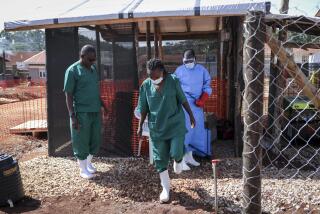Ebola research: Fever not a surefire sign of infection

- Share via
Reporting From WASHINGTON — For public health workers screening more than 1,000 air travelers who arrive each week in the United States from Ebola-stricken West Africa, one symptom above all others is supposed to signal danger: fever.
So long as an individual’s temperature does not exceed 101.5 degrees and there are no visible symptoms of Ebola, health authorities say it should be assumed the person is not infectious.
Yet the largest study of the current outbreak found that in nearly 13% of “confirmed and probable” cases in Liberia, Sierra Leone, Guinea and elsewhere, those infected did not have fevers.
The study, sponsored by the World Health Organization and published online late last month by the New England Journal of Medicine, analyzed data on 3,343 confirmed and 667 probable cases of Ebola.
The finding that 87.1% of those infected exhibited fever — but 12.9% did not — illustrates the challenges confronting health authorities as they struggle to contain the epidemic.
U.S. health officials have repeatedly emphasized that fever is a reliable sign of infectiousness. As a defense against the spread of the virus to this country, the Obama administration has ordered that passengers arriving from West Africa at five U.S. airports be checked for fever.
Dr. Thomas Frieden, director of the U.S. Centers for Disease Control and Prevention, underlined the importance of fever in discussing the case of Thomas E. Duncan, a Liberian who traveled by air to Dallas and was diagnosed with Ebola. He died Wednesday.
Referring to those who had close contact with Duncan, Frieden said a week ago: “The only thing we need to ensure is that their temperature is monitored, and if they develop a fever, that they are immediately assessed, isolated and if found to be positive, then appropriately cared for.”
Frieden has said that about 150 air passengers per day — or 1,050 per week — enter the U.S. from Liberia, Sierra Leone and Guinea, the countries at the heart of the outbreak.
Dr. Anthony Fauci, who is helping to shape the U.S. response to Ebola as director of the National Institute of Allergy and Infectious Diseases, was asked by a CNN interviewer on Oct. 4 whether a person could be “contagious without having a fever.”
Fauci replied that “the answer to that is no.”
He continued: “You never say 100% but it’s essentially 100%. … In biology nothing is 100%, but that’s quite a reasonable conclusion to make.”
Asked in the same interview about screening of air travelers, Fauci said, “Almost invariably, fever is the thing that signals the onset.”
Reached for comment for this article, Fauci said by email that studies of Ebola outbreaks “usually underestimate by a few percentage points the actual percent of people” who have fever.
The official assumptions about the frequency of fever in Ebola patients have not been challenged publicly. But Dr. Paul D. Stolley, former chairman of the University of Maryland’s Department of Epidemiology and Preventive Medicine, said the matter “requires further investigation.”
Given the stakes, he said, the “absolute” assumption that Ebola can be spread only when an infected person displays fever should be reevaluated.
“It may be true,” said Stolley, a member of the Institute of Medicine, part of the National Academies. “It just doesn’t sound very plausible to me.”
As of Friday, the current outbreak had killed 4,033 people, according to the CDC. There is no proven cure for Ebola.
The authors of the recent World Health Organization study said they analyzed “a detailed subset of data” on confirmed and probable cases, including information from forms completed by doctors and other healthcare workers in the affected countries, indicating whether a patient had a fever and at what temperature and whether the reading was taken by armpit, by mouth or rectally.
The study defined fever as 38 degrees Celsius — 100.4 degrees Fahrenheit.
“To create the fullest possible picture of the unfolding epidemic,” the authors said, they collected additional information from “informal case reports” and other sources.
The researchers described imperfections in some of the data. In a footnote, they wrote that “in practice, healthcare workers at the district level often do not have a medical thermometer and simply ask whether the person’s body temperature is more elevated than usual.”
Yet the lead author, Dr. Christl Donnelly, a professor of statistical epidemiology at Imperial College London, stood by the findings on the prevalence of fever.
Asked by email whether the study found no fever in 12.9% of confirmed and probable cases, Donnelly replied: “Yes.”
Three studies of previous outbreaks, cited in the same World Health Organization report, provide further grounds to question whether fever is a fail-safe signal.
Researchers studying an outbreak in Uganda in late 2000 and early 2001 reported that “the commonest symptom … was fever, which occurred in 85% of the cases.”
Another study of that outbreak, focusing on 24 confirmed cases of Ebola, found fever in 88%.
The third study, which examined a 1995 outbreak in the Democratic Republic of Congo, found fever in 93% of 84 people who died and in 18 of 19 individuals who survived.
Asked Friday how many people infected in the current outbreak should be expected to display fever, a CDC spokeswoman, Sharon Hoskins, said “the vast majority” would, but added that it was “impossible to give an exact percentage.”
For doctors and nurses fighting the epidemic in West Africa, the risk of encountering Ebola in the absence of fever is more than academic.
Dr. Nick Zwinkels, a Dutch physician, last month closed a hospital he had been running with a colleague in central Sierra Leone after five nursing aides contracted Ebola — possibly from unprotected contact with three patients who were not promptly diagnosed with the virus.
Four of the nursing aides died, as did all three of the patients belatedly found to have Ebola.
Interviewed by email, Zwinkels said that hospital staff members took the temperature of one of the doomed patients four times a day for three consecutive days, and the patient never showed a fever. The readings were taken by a digital thermometer placed in the armpit, he said.
Based on what his staff observed, Zwinkels wrote, “it seems that only measuring the temperature as a form of triage is insufficient.”
He added: “It seems that Ebola can present without fever especially in the first phase.”
Zwinkels said that without fever as a trustworthy marker, it is difficult for medical professionals to treat the many West Africans suffering from everyday maladies.
The clinic that Zwinkels operated for the Rotterdam-based Lion Heart Foundation was established to treat malaria patients but cared for a handful found to have Ebola, while trying to arrange their transfer to a more qualified facility.
If Ebola cannot be readily identified, Zwinkels wrote, “Ebola patients will be admitted in the normal ward and possibly contaminating health staff and caretakers. This is why a lot of hospitals in West Africa are closed. … Millions of people don’t have any healthcare at the moment because hospitals treat Ebola only or are closed.”
Zwinkels said he looked forward to returning to Sierra Leone and felt torn between raising awareness about the cases he saw and sowing panic.
“This outbreak is completely out of control, and the only way to stop [it] is to find every case, isolate them and trace their contacts,” he wrote.
More to Read
Sign up for Essential California
The most important California stories and recommendations in your inbox every morning.
You may occasionally receive promotional content from the Los Angeles Times.











